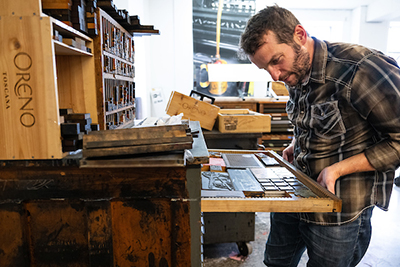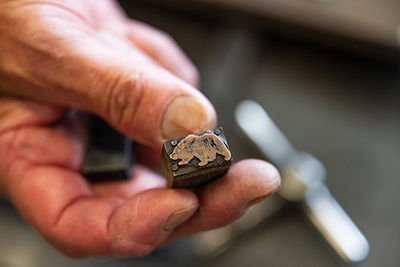Bear Scratch Press: UM Inaugural Printing Class Employs Donated Letterpress
By Raequel Roberts, UM News Service
MISSOULA – As class projects go, this one was decidedly different.
For the better part of an hour, University of Montana graduate students enrolled in Letterpress Practicum sorted through small mountains of metal type, filing each by its letter into a compartmentalized wooden box.
While tedious and an eye strain – pieces were often the width of a pea, sometimes smaller – learning this organizational technique is an important part of operating a printing press. After all, if you can’t find a capital A when you need it, creations come to a halt.
“Sorting type dates back to the advent of moveable type,” said Alexandra Ore, the press assistant for the class and a graduate of UM’s Masters of Fine Arts program in fiction. “It’s a painstaking part of the process, but there’s value in learning it.”
Letterpress Practicum is UM’s inaugural book art class created to complement a 1936 Hacker Test Press No. 5-B donated to the University last summer. The gift included more than 700 pounds of type, including everything from the tiniest 6-point comma to a hand-sized wood type relief of the number eight.
Robert Stubblefield, director of UM’s undergraduate program in creative writing, said the press and type were donated by Missoula native Peter Rutledge Koch, a master book arts printer, and Kevin Head, a UM alum and longtime supporter of the University’s creative writing program.
“Kevin has been a key player in our annual Writers’ Fall Opus, which generates funds for student scholarships,” Stubblefield said. “Through his and Peter’s generosity, we were able to inaugurate the book arts program using this press. We plan to expand the curriculum so more students can experience and enjoy this very artistic form of communication.”
Students in the first class found the manual work of assembling type decidedly different from composing on their laptops.
“Working with cases of type and this huge machine is such a tactile experience,” said MFA graduate student Erin White. “It does take a certain temperament to have the precision and patience, which is what you need as a writer, too.”
White is one of 12 members of the class that consists of graduate students in creative writing, who are themselves poets, as well as fiction and nonfiction writers.

Student Marko Capoferri looks through a small portion of the letterpress type donated, along with the press, to UM. The cabinet behind him holds wood blocks called furniture, that are positioned around type to hold it in place.
Class instructor Professor David Axelrod said there is a long history of poets-and-writers-turned-printers, most notably Leonard and Virginia Woolf, who’s small handpress launched Hogarth Press, which still exists today.
“A beautiful poem is more beautiful when beautifully printed,” said Axelrod, who earned a Master of Fine Arts at UM and taught for 35 years at Eastern Oregon University. “Having the type in your hands gives a deeper appreciation for language then you get with a computer keyboard … a greater appreciation for the lyrical passage of prose.”
Axelrod’s own introduction to printing presses came when he and his wife, creative writing Professor Jodi Varon, started a literary magazine – printed on an offset press – at Eastern Oregon called “basalt: a journal of fine & literary arts” in 2004.
“Around 2006 I cajoled my dean into buying me a Vandercook SP-15 on which I collaborated with visiting writers and my colleague in art, Susan Murrell,” recalled Axelrod of his work with the noted Oregon artist. “You quickly learn with letterpress type that you can never measure enough.”
Rulers, in fact, are as common in Letterpress Practicum as are latex gloves to keep ink and lead off hands and fingerprints off type. The studio, where the 2400-pound press resides, is a chaotic buzz during the weekly class, with students working in groups of three to sort and set type. No one has time to sit down.
“Students at the first class asked if they should bring paper and pencils to class,” Axelrod said. “I told them, ‘Well, you are going to need both hands.’”
During the semester students tackled several creative projects, including a poster featuring text by Montana poet laureate and UM instructor Chris La Tray and a commemorative gift to be given to members of the Office of the Commissioner of Higher Education during their November meeting in Missoula.
But the impromptu also took place. In specific, a poster to celebrate the 50th anniversary of CutBank, UM’s literary magazine that has featured works by such venerated writers as Richard Hugo, James Welch, Louise Erdrich and James Lee Burke.
White, who was editor-in-chief of CutBank during the 2022-23 academic year, was joined in the project by MFA student Jenny Rowe, current editor-in-chief of the magazine. With Axelrod’s help they crafted the overall design, combining text and graphical figures that included the very first cover of CutBank overlayed with images from the 50th anniversary cover.
The work required several hours of positioning type – ultimately held in place by various widths of wood and metal – and laying on the right amount of ink on the press roller using a metal spatula.
“It’s an interesting balance,” White said of preparing the press. “You need gross motor works but also tweezers to fine tune the type.”

All of the works printed on the press are published by Bear Scratch Press.
Simplicity was key in this early project, Rowe said.
“Our plan was to have much more text, but David suggested we stay as simple as possible,” she said. “We’re glad he did. It was pretty labor intensive. It’s definitely rewarding to see how typeface can create beautiful art.”
One of student Marko Capoferri’s first tasks in Letterpress Practicum was cutting mylar used to lift the height of wood type once it’s placed on the bed. The tools are simple, he said.
“While this is a fairly modern press,” he said, “in many ways it’s also ancient technology.”
As a poet, Capoferri found particular satisfaction in manually spacing the letters and lines. Poetry for him is both visual and physical, he noted.
“The sizing of the text and the negative space around words and lines is super interesting,” Capoferri said, “and that you are making these decisions while you are laying out the words.”
While this fall’s course was open only to graduate students, plans are to offer the class to undergraduates in January. The curriculum, Axelrod said, will always be in tinker-mode – much like the setting and spacing of type – because it is about the students and where their creativity takes them.
But every work that rolls off the nearly 90-year-old press will come marked with an image of a creature synonymous with UM: The grizzly bear.
“I wanted to come up with a name for this shop and our creations,” Axelrod said. “This is officially now the home of Bear Scratch Press.”
Editor’s Note: Additional images and video from Letterpress Practicum are online.
###
Contact: Dave Kuntz, UM director of strategic communications, 406-243-5659, dave.kuntz@umontana.edu.